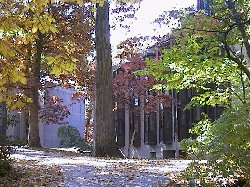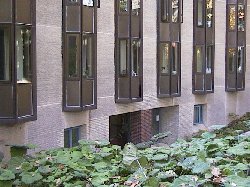

 |
Dana and Hallowell |
|
After Martin was constructed in 1937, no major buildings were added to campus for 21
years because of the disruptions World War II caused. College planners had envisioned
building a female dormitory, a science center, and a library as early as 1946. The
dorm and science center would eventually become Willets and Dupont, respectively. The
library, though, was to be put off until the next series of construction projects. In the 1960's Swarthmore College went on a building spree. The administration anticipated the enrollment to rise to a record 1,200 students within the last few years of the decade, and saw the need to expand its facilities accordingly. The buildings that would become Sharples Dining Hall, Worth Health Center, McCabe Library, and Dana and Hallowell were all part of the same construction project. In February 1965, the College announced its plans to build two more dormitories - one for men and one for women - before 1970. Robert Barr, then the Dean of Men and later the Dean of Admissions, wanted an architect for the new dorms to be selected by early spring. Vincent Kling, a Swarthmore alumnus who designed Dupont, Sharples, and McCabe, would be selected to design the new men's dormitory, Dana Hall. From the beginning Dean Barr made his wishes clear - the dorm he envisioned "avoids straight, long halls, contains a variety of room styles from singles to three- or four-room suites, and blends well into its external surroundings." (Well, 1 out of 3 isn't that bad...) He suggested that the dorms be located just beyond Wharton near the Crum Woods. By October 1965, the plans for Dana were well underway, though the dorm would only house 72 men rather than Barr's requested number of 90. With a few minor exceptions, the floor plans looked almost exactly like what would be built. In a comment to the Phoenix about the proposed plans, Dean Barr stated, "while they are not unacceptable, I would like to see more singles and suites." He went on to say that the plans "displayed a lack of imagination" and "closely followed plans for a dormitory at another college." It was once proposed that the design of Dana resemble that of Mary Lyons, though the administration dismissed the suggestion as "financially out of the question." The College hoped that the new dorm would be between Willets and Worth in conception - by this time, they had acknowledged that Willets was something of a disaster in the eyes of the students. By October it had also been decided to build Dana just beyond Wharton so that the College could "bring unused land into active use [around this time, the administration decided to demolish Sommerville to make room for McCabe; hence their concern about utilizing all available land]... and create dormitories which are not isolated from the campus." The College still planned to build a second men's dorm later on between Dana and Wharton, though it had no intention of decommissioning any of its current men's dorms (such as Mary Lyons). In February 1966, one year after the plans to build a new dorm were first announced, the plans for Dana Hall were nearly complete. The building would be four stories tall, the upper three of which would contain dorm rooms. Each floor would be divided into two sections, each of which would have four singles, four doubles, a lounge, and bathroom. The singles would be 118 square feet in area; the doubles, 216 square feet. The basement would contain a TV and game room, an all-purpose room, a kitchen, and several study rooms. The projected cost for Dana was $550,000. At this time, two different plans had been drawn up for Dana - one in which the rooms were rectangular, and one in which they were trapezoidal. If trapezoidal rooms were used, the building would be curved; this is the design the College eventually decided upon. It was also in late February that the suggestion was first made to build two identical dorms, rather than just Dana alone. On Tuesday, May 3, 1966, the Board of Managers voted to construct two identical dorms. While this would result in a later completion date for the dorms, it would also be more economical - alone, Dana would cost $550,000; two dorms with the same layout were projected to cost around $970,000. Swarthmore learned a lesson from the institutional housing style of Willets and made a conscious effort to reduce the noise level in the two new dorms. Among other things, no section of the hallway would be longer than 12 feet (to prevent noise from traveling), the walls would be filled with sand and 12 inches thick (twice as thick as in Willets), and each floor would not only have a separate lounge space, but the entire ground floor as well. The Dana Corporation of Bridgeport, CT and H. Thomas Hallowell '29 were the major financial contributors of the "Gemini Dorm Project," and so the College named the new buildings Dana Hall and Hallowell Hall in their honor. The dorms first opened to students in fall 1967, and the official dedication ceremony took place at 2:15 p.m. on Saturday, October 21, 1967 - Homecoming Day. The final cost of the two dorms was $1.2 million, well over the College estimate.
|
 Dana and Hallowell |
 Hallowell |
|
 The entrance to Dana's basement |
|
 Dana |
absolut swarthmore
last updated